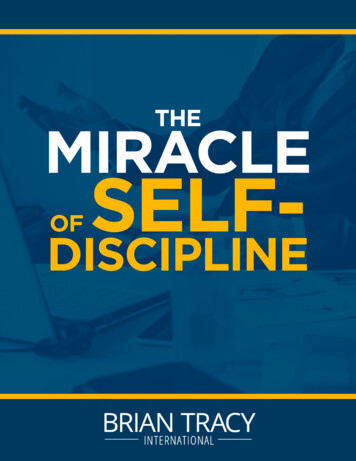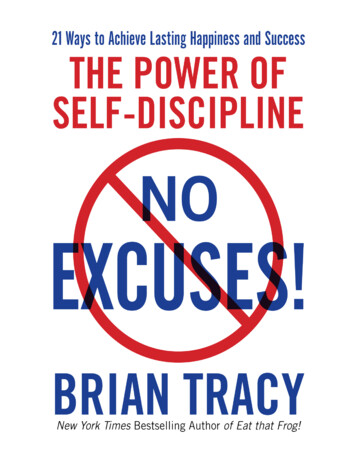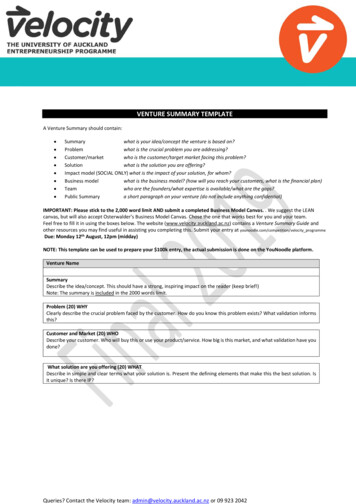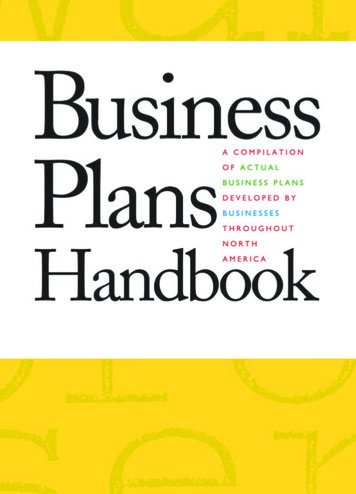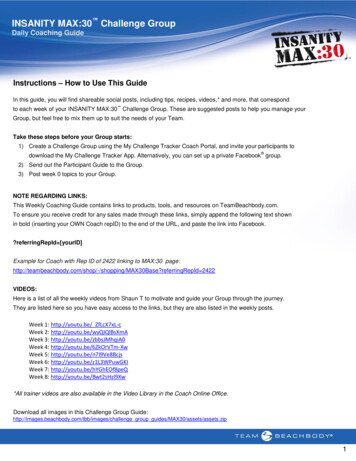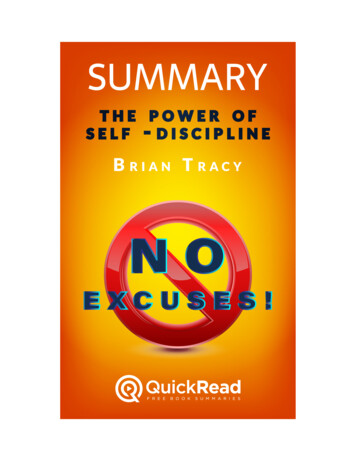
Transcription
Summary of “No Excuses!” byBrian TracyWritten by Alyssa BurnetteIf you’ve ever taken a look at your life and wonderedwhat’s holding you back, No Excuses is literally theanswer.
Introduction5Accept Responsibility, Achieve Success6Adopt the Seven Step Method8Complete the Disaster Report10Self-Discipline Determines Your Success12Achieve Financial Freedom14Avoiding the “Three Whites”16Improve Your Personal Relationships17Final Summary18
IntroductionHow many times do you tell yourself, “I’ll do it tomorrow?” or “I’ll do itwhen I feel better?” What about “I’m too tired right now,” or “I can do itafter I go to this fun thing!”If you’re like me, you probably lean on these excuses far more often thanyou should, only to find yourself scrambling to catch up later as you wonderwhy on earth you did this to yourself. And as you’ve probably noticed,bouncing from excuse to excuse isn’t really living your best life. So, why dowe trap ourselves with excuses and how can we break the cycle? That’s thequestion Brian Tracy set out to answer, and this summary will teach youhow to apply his findings to your own life. By the time you’ve finished thisbook, you’ll learn: What the Seven Step method is What a Disaster Report is and how you can use it to conquer yourfears Why delayed gratification can set you free
Accept Responsibility, Achieve SuccessHave you ever looked at someone else and thought, “How does she do it?”Although that person might not have more time, money, or resources thanyou, it still appears as though they effortlessly accomplish more, leaving therest of us to stare in wonder as we try to figure out why. But there’s nomystery to their success! It might sting a little to hear, but the truth is thattheir success lies in the simple practice of self-discipline.And whether it’s your neighbor who’s got it all together or the CEO of aFortune-500 company, the common denominator of every successfulperson is their commitment to eliminating excuses. But the good news isthat the benefits of self-discipline aren’t exclusive to some secret group ofpeople who have it all figured out. It’s accessible to everyone and you canstart cultivating your own vision of personal success right now!If you’d like to improve your success in your career, one great way to beginis by taking note of experts in your field and what they have to say. Sure,you have the knowledge required to do your job every day, but what aboutlearning something new? What new information could revolutionize yourroutine? You can start finding out by attending professional workshops andconferences or checking out some leading experts’ podcasts. In fact, that’swhat Brian Tracy’s dentist did. Because he was passionate about his work,he attended every dental conference he could. That’s what brought him to aconference in Hong Kong where he learned something that transformed hiscareer.When a Japanese dentist shared a technique that could permanentlyimprove the appearance of a patient’s teeth, Tracy’s dentist immediatelytook this new information back to his practice in the US and startedimplementing it with his own patients. Within just a few years, his practiceexperienced an explosion of success and clients from all across the UnitedStates were traveling to book appointments with him. In fact, by the age of55, he had achieved national acclaim and made enough money to retireearly. If this type of success sounds pretty good to you, the great news is
that it could easily happen to you. After all, attending conferences andlearning new things doesn’t sound too hard. But it’s important to rememberthat even something as simple as learning from others requires onefundamental step: accepting responsibility.In order to learn and make changes in your life, you must first identify andaccept your limitations. One limitation might be the fact that you don’t yethave the knowledge you need to be your best self; accepting that is whatenables you to be humble and learn from others. But acceptingresponsibility is also the first step to eliminating excuses. Whatever youlack in your own life, whatever you’d like to change, it’s critical that youown it and resist the temptation to blame your disadvantages on others.Brian Tracy learned that the hard way and it was that discovery whichmotivated him to write No Excuses. Because after finding himself in a deadend job at the age of 21, with little money, no success, and no sense ofpersonal satisfaction, he realized that was all due to his habit of blaming hisproblems on his childhood and his lack of education.But once he realized that, Tracy instantly set out to redirect his toxicthought patterns. He started buying self-help books and learningeverything he could about self-improvement. He began putting more effortin at his job and giving 100% of himself to everything he did. By making anactive effort to change the negative aspects of his life, Tracy not only retrained his brain, but charted a new course for personal success.
Adopt the Seven Step MethodThis little piece of advice is for everyone who’s struggled to keep a NewYear’s resolution. (And, let’s be honest, that’s pretty much all of us). So, ifyou’ve ever found yourself googling “how to stick to your New Year’sresolutions,” here’s a practical method that you can put in action all yearlong. It’s called the Seven Step method and it’s even simpler than it sounds.Here’s how it works:Step One: Decide exactly what you want. Don’t just write a generic goal like“lose weight” or “make more money.” Identify a specific and realistic goallike “lose 50 pounds.”Step Two: Write down your specific goal.Step Three: Set a realistic deadline for accomplishing your goal. Our failureto identify the amount of time and effort it will take to accomplishsomething is one of the biggest reasons our resolutions fall through. So,when you’re being realistic about your goal, make sure you’re also realisticabout how long it will take you to complete it. And if you’re looking at along-term goal, don’t be afraid to break it into small, manageable chunks.On its own, “lose 50 pounds” is a pretty tall order, but “do 15 minutes ofexercise today” is manageable.Step Four: Write down a list of everything you need to achieve your goal.This includes everything from the struggles you might encounter whileattempting to meet your goal to the tools you’ll need to be successful.Step Five: Identify the most beneficial tasks and prioritize them. Add themto your calendar and complete the high-priority tasks first.Step Six: Start on your tasks right away. Even if you start small, take at leastone practical step to accomplishing something right now.
Step Seven: Do something every day that helps you achieve your goal.Sometimes, that small thing you can do every day might be as simple asasking others for advice. That’s what Bob Barton learned. Bob was afrequent attendee of the author’s motivational seminars and he tookeverything he learned to heart. Because he wanted to get ahead in his careeras a salesman, Bob decided that some steps toward his goal could includethings like paying attention to the senior salespeople at his company andemulating their manners of speech and dress. And while copying successfulpeople helped him out a little, he didn’t begin to see real results until hefinally approached them and asked them to help him accomplish his goal.When Bob asked one of the senior salesmen for a book recommendationthat might help him learn more, his colleague was flattered, and soon allthe senior sales staff began to shower him with advice that ranged frompersonal tips to podcasts. And when Bob disciplined himself to takeadvantage of these resources and really read and listen to them, thetransformation was astounding. Before he knew it, Bob became the bestsalesman in the office!
Complete the Disaster ReportWhat are you afraid of? I’m not talking about the basic things that prettymuch everybody fears, like spiders or heights, but rather, the deep fearsthat keep you from accomplishing your goals. Are you afraid of failure?Afraid of being unremarkable? Whatever your fear is, the most importantthing to know is that it doesn’t have to hold you back. Although they mayfeel insurmountable at times, our fears aren’t hardwired into our brains.Because we learn to be afraid of things over the course of our lives, the goodnews is that we can take control and un-learn those same fears. And one ofthe best ways to un-learn your fears is to complete what Brian Tracy calls“the Disaster Report.” It’s comprised of four simple steps and it works likethis:Step One: Describe your fear clearly.What exactly are you afraid of? What do you think will happen? Whetheryou’re writing it down or simply articulating it for yourself out loud, bespecific about the parameters of your fear.Step Two: Identify the worst case scenario.Often, we get so paralyzed by fear that we fail to ask “If then, what?’questions. So, take a few moments to think about the very worst thing thatmight happen if your fear came true and confront that possibility. As you doso, you may find that your fear is a bit irrational, that it wouldn’t be all thatbad if the worst really happened, or that your fear suddenly seems a bitmore manageable.Step Three: Brainstorm solutions for your worst case scenario.Now that you know the scariest possible outcome, come up with somecreative solutions for what you would do if it came to that. For example,let’s say you’re scared of making an investment because you’re worried itmight go wrong and you’d lose all your money. So, if the worst case scenariois that you lose money in the process, one solution is to acknowledge thatyou could find a way to make that money back. Or you could minimize the
risk and invest less of your income so you’re confident of having a safety netto fall back on. Whatever the worst case scenario is, you can always find asolution that will help you minimize your fear. Acknowledging this is also atremendous first step, because part of the paralysis of fear comes from ourunwillingness to even confront what we’re afraid of.Step Four: Take actionable steps to ensure that your worst case scenariodoesn’t happen. This probably sounds like the most obvious statement ever,but it’s worth putting into practice. Because of course we don’t want ourworst fears to come true, but what practical steps do we take to try and keepit from happening? Asking ourselves what we can do today to make ourfutures more secure is a great way to remind ourselves that our fear doesn’tcontrol us-- we control it.Training yourself to confront your fears right away is another helpful stepyou can take. For example, another of the author’s seminar attendees had atricky relationship with her boss. Although she was a top employee, herboss never lost an opportunity to find fault with her work, which-understandably-- caused her to feel nervous and uncomfortable at work.And after months of dreading any interaction with her boss, she finally putTracy’s advice to the test and simply told him, “Please don’t talk to me thatway. I’d really appreciate being spoken to differently. When my feelings arehurt, I can’t focus on my work or give my best.” And although she wasnervous about her boss’ reaction, the worst case scenario didn’t happen!Instead, her boss apologized and spoke to her respectfully in all futureinteractions.
Self-Discipline Determines Your SuccessAlthough some of our examples have centered on the lives and bestpractices of those who work for someone else, the truth is that selfdiscipline is still a vital part of your success even if you’re self-employed. Infact, it might even be more important then! That’s because statistics showthat the average business owner works 59 hours every week. So, if you’rerunning your own business, it’s critical to be aware of the willpower,consistency, and determination which fuels the successful management ofthat work schedule. In order to maintain it, you’ll need to implement theCANEI method, which stands for Continuous And Never EndingImprovement. Here’s how it works:You know, of course, that when you start a new business, you need to writeup a business plan and identify key things like your target market, pricingstrategies, marketing tactics, etc. But you should also know that thisbusiness plan isn’t set in stone. No matter how well it’s serving you at themoment, there will come a point when your current strategy fails to workfor you, and because of this, you should be constantly on the lookout fornew ways to improve. That’s how you avoid the failures of businesses likeBlockbuster which collapsed because they refused to adapt with thechanging market. So, keep in mind that a successful business is one whichis constantly improving. And to lead that successful business, you mustalways seek to challenge and improve yourself.But the same is true for every employee out there as well! Although youmay not be responsible for the growth of an entire business, you’re 100% incharge of your growth. And although that might not sound like a big deal,maximizing your sense of personal responsibility can actually help you tomove up in your company. Brian Tracy learned that firsthand when heworked for a property development company. He started by giving his bestto every job he was assigned and then asking his boss for moreresponsibility. And as he earned it, he continued to develop his sense ofself-discipline, training himself to get the job done better and faster than
the last time, until he’d beaten his personal best. This ultimately earnedhim the reputation as the “go-to guy” that you could trust to do anythingwell.And once he had that reputation, Tracy just kept building on it, until oneday, he was asked to fly to Reno and start working on a new property thecompany had just acquired. Although he’d only been asked to do it in thenext couple of weeks, Tracy took initiative and flew out the next day to getan early start. By doing this, he discovered that the property had no accessto water and thus was virtually useless for development. Catching thismistake early enabled him to terminate the contract and save his companythe 2 million they would have otherwise wasted! It all goes to show youwhat can be accomplished when you take initiative and practice someaggressive self-discipline!
Achieve Financial FreedomDo you work because you have to or because you want to? For most of us,it’s the former, and we often spend our time fantasizing about what we’d doif we had complete financial freedom. We’d buy a mansion, perhaps, orspend all our time laying by the beach. Every moment we’d normally spendworking could suddenly be spent in pursuit of only our favorite activities.Sounds pretty great, doesn’t it? But what you might not know is that thiscould actually be well within your reach! How can you do it?Well, the first step to achieving financial freedom starts with practicingsomething called delayed gratification. Because our world has gotten fasterthan ever, our expectation of getting exactly what we want at the momentwe want it has increased as well and it’s a death blow to our success. That’sbecause success can only be achieved through self-discipline and selfdiscipline requires patience. So, although it may be tough to master at first,start training yourself to take control with the One Percent Method.All you have to do is set aside 1% of your income and discipline yourself notto touch these savings. And if you think about it, when you’re living off theother 99% of your income, it’s not like you’ll miss it all that much! Becauseif you earn 3,000 a month, 1% is just 30. Is the lack of an extra 30 amonth going to cause you significant hardship? Probably not, and that evenapplies if, like most people, you live paycheck to paycheck. Although youmight miss that extra 30 slightly more than those with a bigger monthlyincome, it’s unlikely that it will have a negative impact on your quality oflife each month. And by setting aside just 1% of your income each month,you can soon build a sizeable savings account that will help you gainfinancial freedom! In fact, if you’re able, you can even try upgrading to 2%of your monthly income and watch your savings grow.Now, that sounds like a pretty manageable path to financial freedom, butwould you believe that cultivating a pattern of smart savings involves morethan just setting aside money? It’s also about time management and for
that, you can use the ABCDE method. Like the One Percent method, it’s justas simple as it sounds, and it’s the best way to cut procrastination from yourlife. (Because honestly, isn’t procrastination at the root of all our excuses?)You can start eliminating your excuses by following these simple steps:A: These are your “must-do” tasks, denoted by the first letter of thealphabet because they’re the things you’ve got to do first. Any tasks that willbring major negative consequences for ignoring them should be put in thiscategory.B: “Should do” tasks go here. While you definitely ought to do them, youprobably won’t die if you don’t get these things done.C: “Nice to do” tasks go in this category. Think writing a card to a friend oroffering to do someone a favor. These are great things and you shoulddefinitely do them if you can, but don’t prioritize your great aunt’s birthdaycard over the presentation that could cost you your job.D: These are the tasks that can be delegated to others. Often when we takeon responsibilities, we assume we have to do every single thing on our own.But in fact, some things could be delegated to people we trust who arewilling to help us take some of the load. So, if a quick errand can bedelegated to your partner, put it in the D category and get on with your Ajobs!E: Lastly, these are the tasks that aren’t essential. Being neither necessarynor nice or otherwise important, these things don’t have to be done and areprobably distractions. Ignore them and focus on your main goals.
Avoiding the “Three Whites”Any book about getting rid of excuses has to deal with exercise at somepoint because exercise is one of the most common things we make excusesabout. And if we’re going to be truly healthy and successful, then workingsome exercise into our lifestyle isn’t just a good idea-- it’s absolutelynecessary. Cultivating healthy eating habits is equally important and one ofthe best ways to develop those habits is the “Thinking Big” weight-lossprogram. Developed by Brian Tracy as an integral part of his “no excuses”ideology, “Thinking Big” encourages users to cut “the three whites” out oftheir diet. These, of course, are sugar, salt, and flour, and step one beginswith eliminating all sugars from your diet. (Ouch!)Although you’ll definitely miss sugary desserts, sweet drinks, and sugar inyour morning coffee, making this choice requires a clear identification ofyour priorities. Because if your priority is to be your healthiest self, youcan’t go wrong with a diet that helps you to shave off one pound a day,increase your energy, and boost your focus. To really maximize thesebenefits, you should also cut out all salt from your meals (goodbye, frenchfries!). And last but not least, eliminate all white-flour products like bread,pastries, and pasta from your diet as well. You’re probably thinking we’vejust asked you to cut out pretty much anything that tastes good and you’reprobably right, but as with every “no excuses” decision, it’s all aboutpriorities. Sacrifice is an essential element of any healthy food pattern, andif your goal is to see real results in your weight loss, this is a proven way toget there!
Improve Your Personal RelationshipsNo excuses means no regrets. That’s one of the best things about it! Becausewhen you remove procrastination as an option and discipline yourself toachieve your goals, the fewer occasions you have to look back and say, “Iwish I’d done ” Our personal relationships are often some of our biggestsources of regret and as such, they’re the perfect frontier for selfimprovement.So, using the methods outlined in this book, take a look at yourrelationships and identify what you need to improve. Do you want to spendmore time with your children? Do you need to remind your family thatthey’re a priority? No matter what you’d like to change, you have the powerto say no to the excuses that are holding your relationships back. You canstart by committing to spend more time with your family, or, if you need to,to practice forgiveness. Learning to forgive is one of the most vital steps toachieving happiness and it’s also critical for accepting responsibility.Because we often blame our parents for problems we have as adults or forchildhood experiences that impact us to this day, it’s easy to use that blameas a means of diverting responsibility away from ourselves. After all, if ourparents messed us up, our toxic patterns can’t really be our fault, right?Wrong! While we can’t control the past experiences that have shaped us, weare 100% responsible for what we do with our lives today. So, if there’sanyone you need to forgive or anything you need to let go of, relinquishthose excuses today and start on the path to happiness.
Final SummaryExcuses are all around us and they’re easy to take advantage of. Butchoosing the easy route won’t bring us happiness and success. Instead, it’sthe quickest way to ensure that we’ll one day wake up and find ourselvesunhappy, unfulfilled, and wondering how we got this way. If you want toreclaim your future and find success, happiness, and financial freedom,you’ve got to say no to excuses and cultivate self-discipline.
Brian Tracy learned that the hard way and it was that discovery which motivated him to write No Excuses. Because after finding himself in a dead-end job at the age of 21, with little money, no success, and no sense of personal satisfaction, he realized that was all due to his habit of blaming

